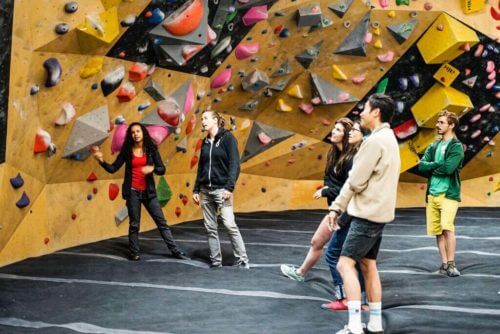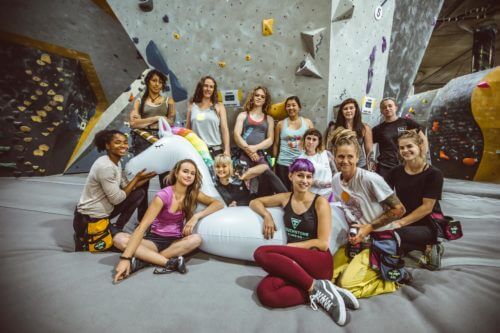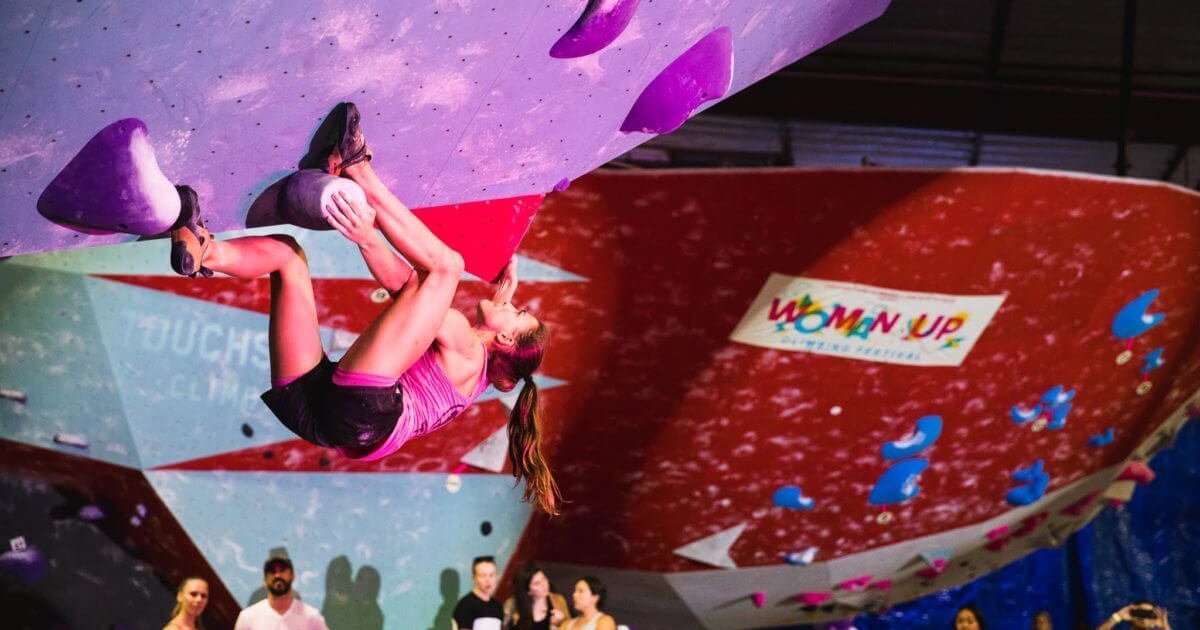Hi Folks! My name is Jackie Hueftle, and I’ve been a Flashed athlete for around 15 years now. I’m a climber and route setter who lives in Boulder, Colorado. I teach clinics, set, and consult with the Routesetting Institute and the Climbing Wall Association. I’m also one of the owners/operators of the climbing hold companies Kilter Grips and Urban Plastix. When I started climbing and setting in 1998, there were very few female setters. I was lucky enough to be encouraged to attend a setting clinic at my home gym, Rocksport in Reno, Nevada, by some of the older setters.
was lucky enough to be encouraged to attend a setting clinic at my home gym, Rocksport in Reno, Nevada, by some of the older setters.
Instantly I fell in love with setting. Even though that first route my friend and I set dropped our instructor mid-forerun. When all 3 holds he was on (one hand and two feet) spun simultaneously. I learned a lesson that day about tightening my holds!
I began setting regularly at the gym, but I competed in local comps instead of setting for them. At the time, I was still on the junior climbing team. As soon as I aged out of juniors, I was conscripted to set. I remember the responsibility I felt setting my first semifinal route for a JCCA (now USAC) Regionals.
As a former competitor, I knew how important it was to get the route right. How minor tweaks could drastically change the event’s outcome. We set overnight, as it often went for comps back then. The gym had to stay open as long as possible for other customers. Watching competitors give their all on the routes our crew had worked so hard to make right was highly satisfying. From then on, I knew I preferred setting comps to competing in them.
How do I get into setting?
When I moved to Boulder, I started setting at The Spot and eventually became the Head Setter. In addition to years of the Spot Bouldering Series comps, I set Nationals with USA Climbing and other big Pro Opens and events, including the Mammut Bouldering Championships and Touchstone’s Woman Up. I still love both commercial and competition setting, though these days, I mostly set for myself in the Kilter Barn or on the Kilter Board unless I’m doing a clinic or gym reset.
One of the top questions I have gotten over the years is: “How do I get into setting?” Since the climbing industry is growing and becoming more professional, it’s not as easy as starting route setting. The days where gym members could set if they felt like it or set in exchange for their memberships are rapidly going by the wayside, and most climbing gyms have a more professional crew of trained setters.
Many gyms have instituted training programs, and more and more setters are seeking additional opportunities like CWA Work at Height Certification and USA Climbing Routesetting Certification. The CWA and USAC are working together with International Organizations like the IFSC to standardize further and professionalize route setting. We can expect to see more opportunities and a more well-defined career path for both commercial and competition setters in the future.

What can aspiring setters do right now?
Setting departments often have maintenance tasks that can be done by interns or volunteers. Still, sometimes insurance policies dictate what non-employees are allowed to do, so the gym may be limited depending on how they’ve structured things. Some gyms have paid internship programs or similar opportunities that you can apply for. If they don’t have an existing program, they may be willing to start one.
Make sure the Head Setter knows you’re interested and you’re willing and able to do what you can to be involved and start to learn. If you already work for the gym, that can be a plus, and sometimes to work your way into setting, you’ll also have to work the front desk or in another department like coaching. These jobs go hand in hand with setting as they allow you to know better and understand the gym’s user groups so, when you do get to set, you’ll do a better job of taking care of the gym’s member base.
If your gym has no structure in place:
Approach your gym’s Head Setter and express interest in route setting. Ask what you’d have to do to learn to be a setter at the gym.
Ask if you can help forerun so you can start to learn how setters think and how problems are tweaked.
If you are allowed to help forerun, listen and learn as much as possible. Be as helpful as possible, whether that’s helping move ladders, pre-chalking, cleaning up holds, labeling problems, fetching tools, etc.
If you’re not allowed to help forerun, ask if you can watch. Even watching and listening can help you learn (though setters generally prefer not being stared at while they’re working, so make sure you talk to the Head Setter first and don’t be there every day unless permission has been granted to you).
Offer to help:
Setting departments often need help: Washing holds, Cleaning up/organizing the setting closet. This also helps you familiarize yourself with the holds the gym has and the tools and practices of the setting department.
Stripping walls and picking up holds.
Sorting bolts.
Bolts often need to be sorted by size. This will help you familiarize yourself with bolt sizes and learn what a good bolt looks like and what bolt burrs and other problems look like.
Fixing volumes or t-nuts
Although this type of work requires skill, it can be learned if you are handy, and the gym‘s structure allows people in your position to perform it.
Get Creative:
You can make up problems by linking existing holds on the wall. This can help you start to experiment with movement.
Use a board system like the Kilter Board and set your own problems in the app. Use draft mode and climb as you’re setting to get the problems where you want them, then save them and release them into the database for everyone to climb!
Get outside help:
Another way to get into setting is to attend a public Intro to Setting or Setting 101 clinic. Some gyms will offer these with an in-house setter or bring in an outside instructor.
Organizations like the Routesetting Institute (www.routesettinginstitute.com) will often teach an advanced in-house setting clinic and a Setting 101 clinic in the same week to both help the gym’s existing setters and to let interested folks try setting out and see if they want to pursue it further.
The BIG Initiative (https://thebiginitiative.ca/en/) clinics are designed to bring new setters into setting, as is the Intro to Setting clinics at Touchstone’s annual Woman Up festival.
The Climbing Wall Association often hosts setting clinics at their Summit and CWA Meet-Up Events (www.cwapro.org).
There are other clinics and events out there as well!
To find out about these kinds of opportunities, tune into industry news like Climbing Business Journal (www.climbingbusinessjournal.com) and follow your gym, these groups, and other setters and setting groups on Instagram and other social media.

What if you only want to set comps?
It’s important to understand that a Comp setting and Commercial setting are not the same, but those who think they only want to set comps will still be well-served if they start setting in a commercial gym.
Commercial gym setting is a great way to get a lot of experience relatively quickly, and also, setting in a gym means every week you get to watch members climb your routes and problems, which will help you learn much faster what works and what doesn’t. Through first-hand experimentation, you will see how different moves, holds, and angles work for different sizes and types of climbers. This kind of learning is important to make you a more efficient, effective comp setter. So, all setters should aspire to spend some time working in one or several commercial climbing gyms.
USA Climbing’s Routesetting Certification system is a clinic system for experienced commercial setters who want to set USA Climbing Regional, Divisional, and National level competitions and potentially progress to setting IFSC/International competitions. The design of their system is to help setters learn to work efficiently to create effective competitions that select and prepare USA Climbing athletes for International level events. If you aspire to be a USAC setter, start in a commercial gym. Once you have some experience and a good grasp of the mechanics of setting, tool use, ladder use, and Work at Height, apply to take a USAC Level 1 clinic and then go from there.
How do I grow as a setter?
Like anything, learning to set well consistently takes time and practice. Set as often as possible so you can gain experience with both the mechanics and the factors behind all the decisions and educated guesses setters make every day. On top of that, you should watch people climb your climbs. Coach if you can so you understand athletes. Set local competitions and events. Volunteer to judge events. Seek your CWA Work at Height certification. Join setting groups. Follow setting social media. Watch World Cups and Nationals online. Look up comp analysis like that done by Udo Neumann (@udini). And guest set when you can so you are familiar with setting in different facilities and with different setting ideas. If there are any setting movement or theory clinics nearby, consider attending so you can absorb more new ideas and movement styles.
Make sure you climb a lot. Indoor and outdoor climbing in various areas will help you better understand movement and give you fresh ideas to bring back to your route setting.
Finally, have patience with yourself. Remember that those of us 20+ years into setting are still learning about setting, and an open mind and willingness to learn is the key no matter your experience. Climbing movement is infinite, and setting is temporary. Take your time, try things, and enjoy the process!


